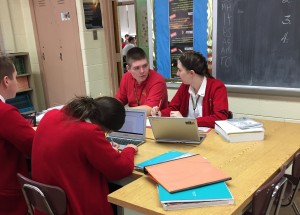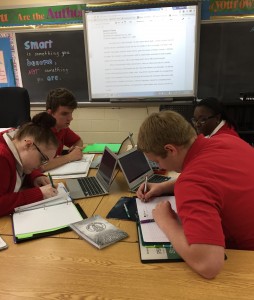Group work has been part of my teaching repertoire since 1981, with varying success. As I become more aware of the need to teach not only my content but also the literacy skills that are necessary for success, I love when a strategy also helps students uncover ways for learning that they can use not only in my class, but in learning in other situations as well.
I believe that helping students learn how to be productive while working with a partner is something that will serve them well in education and in the real world. Certainly, collaboration is one of the skills that employees list as a factor in hiring.
Two of my favorite activities for pairs hit the mark for all four skills–speaking, listening, reading, and writing. In the past wee k, I have had the opportunity to use these strategies in my classes, and I believe the students not only learn better, but they work better together because they have a clear focus and direction.
k, I have had the opportunity to use these strategies in my classes, and I believe the students not only learn better, but they work better together because they have a clear focus and direction.
Summary Pairs
Often times, even the best readers struggle with reading dense text. I know that I have experienced the frustration with not being able to settle in and comprehend a piece that is complicated, so I appreciate the struggle my students might encounter.
Summary Pairs is a strategy that has great implications as a tool for our students’ toolkit.
Students work in pairs, alternating reading a paragraph out loud. At the end of the first round of oral reading, the two co-create a summary statement, working to retain the original ideas but in their own words. The other student reads the next paragraph, and together they write a summary statement for that section. They continue until the whole piece has been read and summarized.
This is a great activity to use before introducing Kelly Gallagher’s Article of the Week or even John Collins’ Ten Percent Summary. Summary Pairs gives them a structure to divide the reading and summarize sections without it being overwhelming.
Furthermore, this activity provides a springboard for summarizing larger chunks of material. As we move into research, my students are often overwhelmed with how to summarize and/or paraphrase information. After they master Summary Pairs, they can easily and confidently move into summarizing on their own.
Reciprocal Teaching
When a piece of writing is extremely difficult, either because of the way it is written or because of the content, Reciprocal Teaching is a strategy that offers students a framework for demonstrating their thinking.
Similar to Summary Pairs, students work through a paragraph at a time, with one partner reading aloud while the other listens. The difference, however, is that the partner reading aloud stops during the reading and talks about what is going on in the text. Students might discuss the meanings of words, the shades of meaning of words, or the moves that the author is making. Students notice things that are interesting, things that make them wonder, and things that are confusing.
This interaction with the text is what I want my students to be able to do routinely. It is close reading at the sentence, phrase, and word level.
To get my students to the point where they can read at this level independently, they need lots of practice working with others so that they can become more confident of their own ideas. Not only does this strategy provide the support they need , but it also allows me the opportunity to purposefully pair students so that they can learn from and with one another.
, but it also allows me the opportunity to purposefully pair students so that they can learn from and with one another.
Key features
There are many reasons why I find these strategies beneficial. First, they include all four skills–listening, speaking, reading, and writing. The strategies provide a framework for students to use as they work through dense reading. Sometimes students do not have the fortitude or stamina to handle a dense piece on their own, so this actually “teaches” them how to approach reading by having them demonstrate for each other the things that good readers do–without the students even realizing they are modeling.
Working like this gets kids up to their elbows in text, demonstrating ways to make meaning and providing lots of support for each other to be successful. And, ultimately, it helps them learn ways to approach difficult text on their own.
Good ideas. I look forward to stealing them.